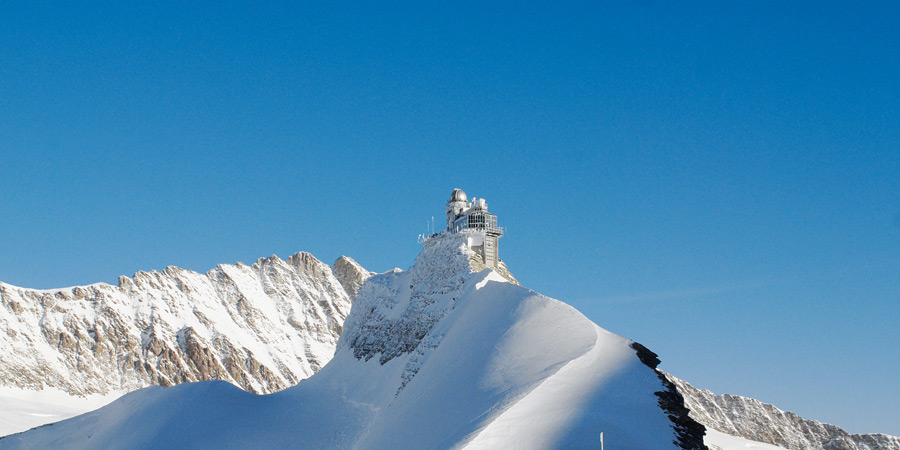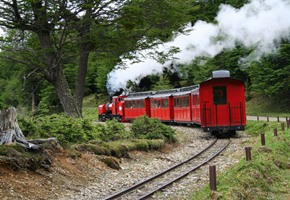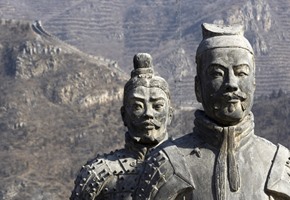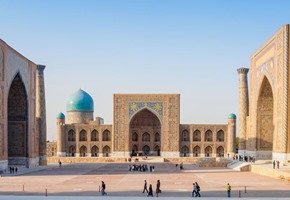Stewart Creasey travels on the Jungfrau Express just after the first snow of winter has fallen across the Alps.
The town of Meiringen feels about as far away from the 'Top of Europe' as you could get. Nestled in the foothills of the mountains, it really isn't much more than a sleepy village - quiet, unspoilt, fiercely proud of its association with Sherlock Holmes, and convinced that it invented the meringue.
While both of its claims to fame may indeed be fictional, Meiringen is not short of appeal. Its location is ideal for exploring the Bernese Oberland and the many Alpine treasures which surround it, yet the town hasn't been undermined or changed by an influx of tourism and has retained its old-fashioned appeal. As is the case with almost everywhere in Switzerland, Meiringen is well served by the country's famous railway system. Regular services connect the town with larger resorts nearby, such as Brienz and Interlaken to the west and Lucerne to the north.
It is to Interlaken that we head as we begin our journey to Jungfraujoch - the highest railway station in Europe. Today is the centrepiece and highlight of our week in Meiringen, and is eagerly anticipated by everyone in the group; we all got an early night last night! The first of today's railway journeys takes us around Lake Brienz to the aptly named city of Interlaken - its location is exactly between two lakes, Thun and Brienz.
Interlaken is one of Europe's most popular 'base camps' - for that is what it really is; a starting point and base station. While the city is pretty and charming in its own right (and it certainly is), the main reason to visit Interlaken is for the beauty and adventure which surrounds it. Trips into the mountains, including the Jungfrau Railway, are plentiful, while some of Switzerland's major cities are within easy reach. It is a popular, year-round destination for skiers and mountaineers, walkers and climbers, and provides a great base from which to enjoy lakeside strolls and relaxing lake cruises.
Today, like so many before us since the days of the Edwardians who came here on their holidays, we have come to Interlaken so that we can go somewhere else. We change trains, heading for Lauterbrunnen, a short distance south. As we pull out of Interlaken, we pass countless charming, typically Swiss chalets, built close to the railway line. Their balconies are filled with flower boxes, as the owners know they'll be seen by so many passengers on the frequent trains. After gently climbing to Lauterbrunnen, it is time to change trains again; we'll use a total of eight trains today, each timed perfectly to connect with the next. The efficiency of the Swiss railway system is no myth; the trains arrive on time and on the very few occasions when they are delayed, connecting trains will wait, using up the spare time built in to the timetable to ensure passengers are not inconvenienced by missed connections.
From Lauterbrunnen, the real ascent begins. We climb upwards more steeply, using the 'rack-and-pinion' system to travel through the trees towards the ski resorts and open pistes. There has been evidence of snow throughout the journey, but as we reach Kleine Scheidegg, it is everywhere. Not on the platform or the pathways - that snow has been cleared long before we arrived. But on the rooftops and the trees, and on the hillsides around the town, the snow is taking over. It is clear we are in a ski resort, even though the skiers are yet to arrive; it is well over a month before the real ski season begins.
Our fourth train of the day is the Jungfrau Railway, another rack-and-pinion service. The line was built in stages from 1896, finally being completed in 1912. It has been an electric railway since its inception, a necessity considering much of the journey is spent in a tunnel through the mountain. Shortly after we leave Kleine Scheidegg we enter the tunnel, carved into the mountain by hand. The next 4.43 miles are spent in the tunnel, and for the first time I am aware that a video is playing on TV screens inside the carriage. In fact, this is the first time I've not been staring at the beautiful scenery on show through the window. The video describes, with old photographs and animation, how the railway came to be and the history of its construction.
As we climb towards the summit, the train stops at two makeshift stations. Firstly, at Eiger Wall, there is a viewing area with huge glass windows looking down from the infamous North Face of the Eiger towards the sleepy village of Grindelwald below. After shuffling back onto the train, we continued up to the Eismeer station, where a similar observation area provides fantastic views across the Grindelwald and Fiescher glaciers.
Finally we reach our destination at Jungfraujoch, the highest railway station in Europe, 11,333 feet above sea level. We are still in the mountain as we alight the train. A lift carries us up to the main Jungfraujoch visitor centre. For some, this is a fantastic, futuristic building, somewhere between an astronomical observatory and a space station. For others it is little more than a giant grey monstrosity, a blot on the landscape of this UNESCO World Heritage site.
Regardless of what you think of it (and I quite like it), it is hard to care as you stare out across the Aletsch Glacier, a magnificent 13-mile-long river of ice. The scenery is awe-inspiring. I'm told that on a clear day (and today is the clearest of days) you can see as far as the Vosges Mountains in France and the Black Forest in Germany. I must confess that I couldn't identify either, although if someone had said they could see the white cliffs of Dover, I might have believed them - that's how great the view is.
Standing outside on the 'observation plateau', the sun is warm, but the breeze is bitterly cold. The only clouds in the sky are hovering in the valley below us. I'm glad to have followed the Tour Manager's advice, handed out over breakfast this morning in Meiringen, where it had been mild and overcast. Sun cream, as well as a warm hat and gloves, were "essential", we were told. I was very glad of both, and I was more than happy to share my sun cream supply with those in the group who didn't believe the Tour Manager when he said we would need UV protection!
As I rushed around, trying to get as much done and take as many photos as possible, I became aware of how thin the air was at this altitude. I was tired going down the stairs, so much so that I needed a quick rest. I would use the lifts from now on. As I made my way around the visitor centre, I found an a la carte restaurant, a café, a gift shop and a post box (the highest in Europe too, I would assume). There is also the Ice Palace, inside which are a labyrinth of tunnels and some intricate ice sculptures, featuring eagles, penguins, polar bears and mountain goats.
After a few hundred photographs and a quick coffee, it was time for our group to leave the Top of Europe. Reluctantly, we returned to the platform, forgetting that we had the pleasure of four fabulous railway journeys to come before we would arrive back in Meiringen.





